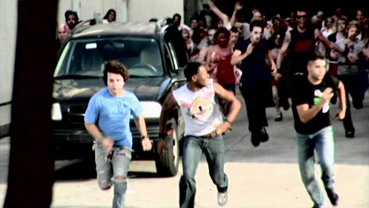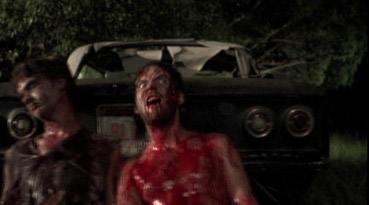|
The first thing you should know about Zombie Transfusion is that it's not called Zombie Transfusion at all. That might be what it says on the box but not on the film itself, which is presumably why my initial research produced so few results. The film is actually titled Automaton Transfusion, and since that's the title still on the print on this very DVD, I'm left wondering just why it's being marketed in the UK under this alternative, presumably director unapproved label. I've come up with three possibilities. See what you think:
- The UK distributor doesn't think us Brits will respond to the word 'Automaton' or perhaps even know what it means;
- By changing the title, they hope to make it harder for us to pick up on some of the more negative reviews and IMDb comments;
- They're hoping to cash in on the current resurgence of enthusiasm for the zombie movie, spearheaded by Ruben Fleischer's hit horror comedy Zombieland.
Or just maybe it's a combination of all three. Either way, the film in the box is indeed Automaton Transfusion, a micro-budget zombie movie shot in nine days on mini-DV by a group of young American genre enthusiasts. It's the first film of a proposed trilogy, and if you like this one then you are certainly going to want – nay, need – to see the next one. I'll get to why in a minute.

The Zombie movie, as we all know, may stretch back to the Val Lewton and perhaps a little beyond, but has as its style-setting grandfather George Romero's Dead trilogy, which effectively drew up blueprint for almost every such film since. This has tended to cast a shadow of sameness over the subsequent movies, whose scope for alternative takes on the central concept has proved considerably narrower than that of the vampire movie, to choose a favourite example. In the zombie movie the dead rise en masse and attack the living, and it's almost always about the fight for survival of a single group, most or all of whom will be dead by the end. The zombies are rarely defeated, and if there's a reason for their reanimation it only becomes clear as the story progresses.
And so it is with Automaton Transfusion, which is what I shall refer to it as now as that's what it's called. Tim, Scott and Chris are buddies at a high school where a student goes batshit in class and takes a bite out of his teacher. When he springs out into the corridor to look for his next meal he's punched out by Scott, who's frankly too cool to be hanging round with the nerdy Tim, but such is the nature of horror flick friendships. Tim and Scott then team up with Chris and hit the road for a concert in the big city, while Chris's girlfriend Jackie joins her cheerleader chums for a party at a house that looks spookily like that one in Night of the Living Dead. The house is attacked by zombies, but Jackie's in the bathroom and escapes the slaughter taking place in every other room. The boys, meanwhile, are spooked by the fact that it's the rush hour and they've not seen another car for forty-five minutes. When they reach their destination they find out why when an army of zombies chases them into a bar, in which they barricade themselves with a shotgun-waving bartender and wonder what the hell they're going to do next.
If you know your zombie movies then you'll realise there's nothing new here, with even the climatic (and vaguely silly) revelation about how this all came about mutated from Romero. Not all is by the book, though. The zombies here are smarter than usual and can run like they've eaten five Shredded Wheat apiece, and as anyone who has been chased by those underground ghouls in Fallout 3 will tell you, a fast moving zombie can be a lot more alarming than a slow shuffling one. Purists might claim it breaks with genre tradition, but the precedent was set back in 1985 with Dan O'Bannon's Return of the Living Dead and the trend continued with Danny Boyle's 28 days Later (OK, they weren't technically zombies, but that was still a Zombie movie, no question of it), Zack Snyder's frantic Dawn of the Dead remake and Charlie Brooker's TV series Dead Set, to name but a few.

Given that most Zombie flics are minor variations on the same theme, the fact that this is largely second or third hand stuff will not come as a major jolt to genre devotees. But then Automaton Transfusion was made by genre fan boys, who do have a tendency to imitate rather than innovate, and what there is of a storyline functions largely to connect one set-piece to the next. But within this self-imposed narrative straightjacket, the film still manages to impress in the energy and intermittent inventiveness of its execution. The waggly camerawork and fast shutter speed that some have complained about will be familiar to anyone who's actually been watching movies and TV for the past four or five years, and together with some kinetic tracking shots create an urgency that's further augmented by consistently tight editing. Angles are often well chosen, none more so than the boys' alarming first encounter with the city zombies, who charge at the hapless trio with the speed, aggression and weight of numbers of an army of demented and cannibalistic Millwall supporters.
There aren't any award-winning performances here, but no-one disgraces themselves either and some are a lot better than the film's amateur origins might suggest. Adult supporting characters are well enough handled, and when Simone (Ashley Elizabeth Pierce) breaks down into hysteria she manages to sell it as real. The violence is also more convincing than you might expect, achieved through a combination of decent make-up effects and camerawork that's too frantic for us to easily spot the flaws. The most wince-inducing death – a fall from height and a head collision – is achieved mainly through camera angles and editing, a technique also employed in the censor-baiting sequence where a zombie tears the unborn child from a screaming mother's womb and tucks in to that instead of her.
Pace and energy aren't everything, of course, and the lack of a solid storyline or a decent subtext does make itself felt, though there are just enough inventive touches to keep déjà-vu from overwhelming the by-the-book plotting. The real sting is saved for the end and it's one you'd do well to be ready for. This is, as I said, the first part of a proposed trilogy, but one whose storyline is intended to span all three films. Automaton Transfusion thus does not conclude, but build to a cliffhanger moment and then throw up a caption saying "to be continued." If you're into the film and not ready for this then you're likely to be shouting obscenities at the screen. And given that part 2 is still in production three years on, I'd say you'd have every right.*
OK, Automaton Transfusion was shot on NTSC mini-DV and then reframed at 2.35:1, cutting the resolution down even further. Oh wait, did I say 2.35:1? Sorry, that's the ratio it's supposed to be, not the copped 1.78:1 picture we have here. Well at least it's anamorphic. Inevitably the picture quality is way short of a decent film or HD originated transfer. Almost all of the night footage and some of the daytime stuff looks grubby, with the darker scenes in particular lacking detail and boasting plenty of digital grain and compression artefacts. It's never that sharp, of course, but occasionally displays better detail than I was expecting, and the contrast and even colour in daylight scenes are pretty good, though are noticeably less so once darkness sets in. Perhaps the biggest problem here are the intermittent motion glitches that produce a pronounced stutter on camera moves and fast action. I was ready to put this down to a shoddy NTSC to PAL transfer, but apparently it's also present on the US disc.

The Dolby 2.0 stereo soundtrack does the job well enough, despite some of the dialogue drifting towards incoherence. The music and effects are clear and there some effective deep rumbles to crank up the atmosphere.
Only a Trailer (1:08), which is a bit weak given that the American Dimension DVD boasts an audio commentary with writer/director Steven C. Miller and producers William Clevinger and Mark Thalman, a 26-minutes making-of documentary, four deleted scenes, Miller's short film Suffer or Sacrifice and two Miller-directed music videos. It also had the film in the correct aspect ratio, albeit without anamorphic enhancement.
The sort of energetic, low-budget, do-it-yourself indie horror that I can't help liking, in spite of its recycled ideas, disregard for story and frustrating non-conclusion. The degree of bile that some have hurled at it certainly suggests that it's doing something right, but that lack of substance does mark it down for zombie movie enthusiasts only, and the incorrect aspect ratio, picture motion glitches and woeful lack of extras – the commentary is particularly missed – make it hard to enthusiastically recommend the DVD.
|